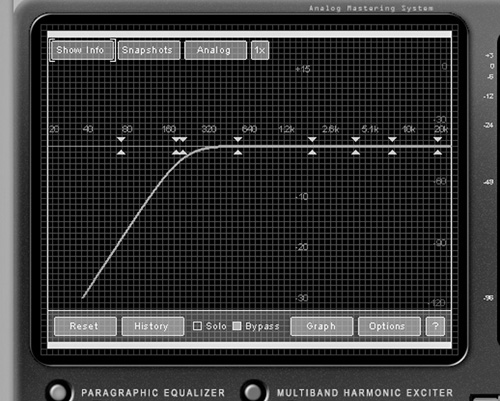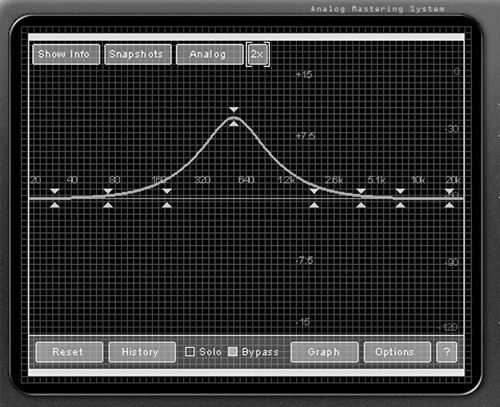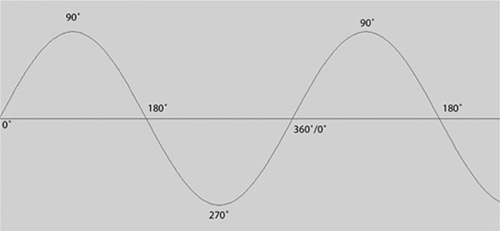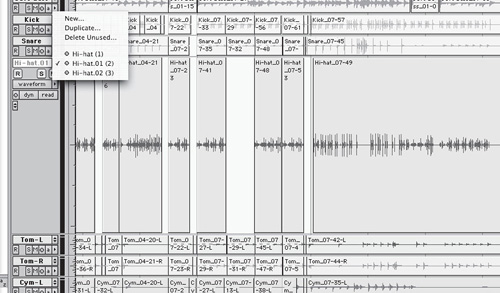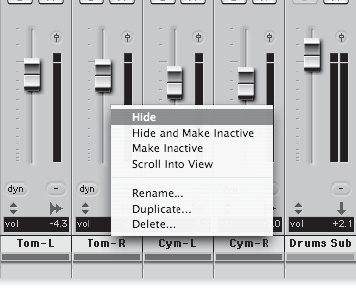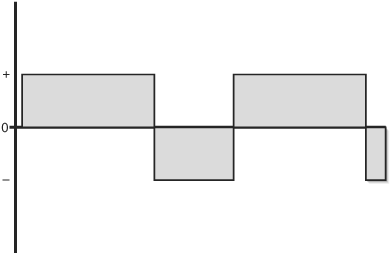Pa. ![]() See pascal.
See pascal.
PACE. A company (PACE Anti-Piracy) that makes copy protection software and hardware, such as the iLok, used by some music and audio companies.
pad. 1. A control found on microphones, mixers, preamps, and other gear that attenuates the level of the incoming signal so it won’t overload subsequent circuitry. 2. A background, string-like, sustaining sound, often produced by a synthesizer, that fills in an arrangement with chords or washes of sound.
page. 1. A screen or window full of related commands, parameters, and functions in a software program or LCD display of a piece of hardware. There might be a page (screen or window) of hardware input and output parameters, another page of digital sample rate and resolution parameters, a page of internal bus routing options, and so on. 2. A contiguous, fixed-length block of computer memory. The computer’s processor architecture determines the page size, often 4,096 bytes. The operating system allocates memory to programs in pages. ![]() See also paging.
See also paging.
paging (a.k.a. swapping). Transferring pages from main memory to a hard drive or other storage device. Paging allows a computer to use hard disk space to hold files or data that are too large to fit in RAM or to use a hard drive or other storage device to temporarily hold data when RAM is full.
palette. A small graphic window in a software program that provides quick access to commonly used commands or tools. See Figure P.1.
pan. A term that comes from the film world, where a camera is turned to capture the panorama of a wide background scene. In audio, a pan control is used to position a sound or track in the left/right stereo field. A surround panner takes this to the next level, positioning the sound in a surround or multichannel field.
pancake. A length of analog recording tape wound on a tape hub, but without the reel flanges (sides of the reel). Pancakes of tape were more economical for studios to purchase than complete reels.
panel trap. ![]() See membrane trap.
See membrane trap.
panic button. A command or button found in most sequencers as well as in some hardware devices, such as MIDI patch bays or interfaces, that is intended to stop stuck notes. A panic button may send a MIDI all-notes-off command or it may send a note off message for each note for every MIDI channel supported by a device.
panner. ![]() See panoramic potentiometer.
See panoramic potentiometer.
panoramic potentiometer (a.k.a. pan pot). A control that varies the balance of a signal’s level in two or more output channels. ![]() See also pan.
See also pan.
pan pot. ![]() See panoramic potentiometer.
See panoramic potentiometer.
parabolic reflector. Think satellite dish...a parabolic reflector is a dish-shaped device used with directional microphones for picking up distant sounds. The reflector collects and focuses the sound energy onto the microphone, which faces backward, into the dish. Parabolic reflectors are commonly seen on the sidelines at football games and other sporting events and are used for capturing wildlife and other sounds where it is difficult to place a mic close to the source.
paragraphic equalizer. An equalizer that combines aspects of parametric and graphic EQs. Usually this means using sliders for parameters such as boost/cut, while also allowing control over bandwidth and frequency settings with rotary controls. Although hardware paragraphic EQs exist, paragraphic software plug-in EQs are far more common.
parallel. Items, events, or processes that occur simultaneously. In audio, an example of parallel might be splitting a signal, then sending it simultaneously through two (or more) processors. In computers, parallel might be multiple simultaneous operations or bits of data sent side by side simultaneously down multiple wires or paths. SCSI is an example of a parallel computer protocol. ![]() See also series.
See also series.
parallel port. A type of connection port used on Windows PC computers for connecting hard disks, CD-ROM drives, printers, and other peripherals. Parallel ports are faster than serial ports, which send data sequentially, as multiple pieces of data can be sent simultaneously.
parallel processing. Splitting a signal and routing it through multiple channels and/or processors simultaneously, then recombining the signal. See Figure P.2.
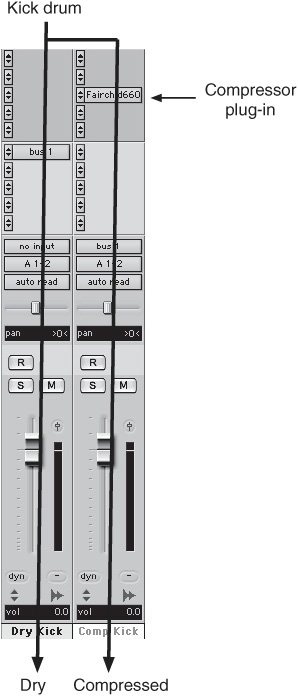
Figure P.2. Parallel processing can be used to make a kick drum sound bigger. In this example, the kick signal is simultaneously being routed through a dry (unprocessed) mixer channel and through a compressor on another mixer channel. The dry and compressed channel outputs are combined, and the levels of the two signals are balanced to achieve the desired result.
parameter. A factor that defines the conditions of operation for a piece of gear or software or a system. Basically, this means any of the settings that the user makes when operating a device or program.
parametric equalizer. A type of audio equalizer invented by producer/engineer George Massenburg that features separate controls for gain, bandwidth, and frequency for each EQ band. See Figure P.3.
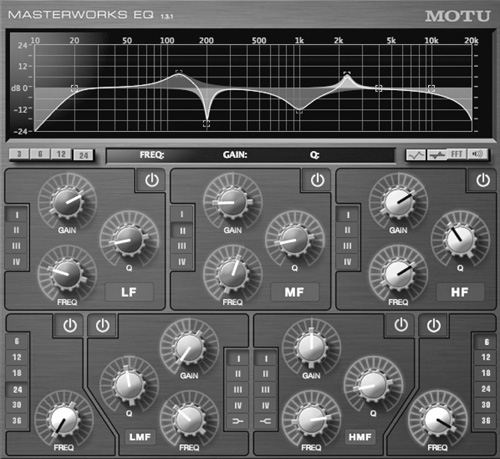
Figure P.3. A parametric EQ allows control over the frequency, boost/cut, and bandwidth of each band.
parity. Literally, equality. In computers, parity is a technique for ensuring that data has arrived completely and unaltered when moved or transmitted. In one scheme, the number of bits is counted in a group of data. If the number is even, a parity bit is set to on; if the number is odd, the parity bit is set to off. The computer counts the bits again after transfer, and if the count matches the parity bit for odd or even status, then all is assumed to be well. There are more complex forms of parity, some of which can be used to reconstruct missing or damaged data.
part. In a multitimbral keyboard, sampler, or synthesizer, a part is a virtual “slot” that can be assigned a sound and a MIDI channel, and that functions as an independent sound module. The sound generator is split into multiple independent parts (8, 16, 32, or even more), which can be addressed either from an internal sequencer or using MIDI. (See Figure P.4.) The number of parts is not related to the unit’s polyphony, which is the number of notes a sound generator can produce simultaneously. ![]() See also multitimbral.
See also multitimbral.
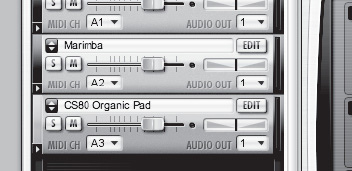
Figure P.4. Each part in a multitimbral synthesizer can be set to produce a separate sound, on its own MIDI channel, with its own volume, pan, and other parameters.
partial. ![]() See overtone.
See overtone.
partition. 1. To divide a hard drive into separate parts. 2. A subsection of a hard drive that has been configured to function as a separate, independent, virtual drive. Partitions appear as separate drives to their host computer. Partitions are usually used to organize data. One partition might hold audio recordings, another might contain sample libraries, a third digital video, and so on. In other cases, partitions are set up to be accessed by different devices.
pascal. The unit used when measuring pressure, or force per area. In audio and sound terms, one pascal (1 Pa) is 94 dB SPL. The pascal is used as a reference when measuring microphone sensitivity and signal-to-noise ratio. For example, the sensitivity rating for a microphone might be –36 dB referenced to 1 V/Pa. Named for Blaise Pascal, a 17th-century mathematician/physicist/philosopher.
pass. A single attempt at recording a track. A number of passes or attempts may be required for the musician to perform his part correctly.
passband. The range of frequencies that a filter allows to pass through unattenuated (see Figure P.5). The limit of the passband is determined by the filter’s 3 dB down points—the frequencies where the response has been attenuated by 3 dB. ![]() See also stopband.
See also stopband.
passive. A device that does not contain any active, or powered, components.
passive monitor. A type of studio speaker that requires an external amplifier and that does not contain any active, or powered, circuitry.
passive radiator. A speaker driver that is not connected to an amplifier, but that moves in response to sound energy inside the speaker’s cabinet. In most cases, a passive radiator resembles a low-frequency driver and moves sympathetically with the motion of a low-frequency driver in the same cabinet powered by the amplifier. Passive radiators are used to lower the speaker’s resonant frequency and to increase low-frequency response.
password. An alphanumeric code that allows the user to access a piece of software, a computer, a website, or functions of a device.
paste. A command that inserts data from a clipboard or other temporary holding space into an active document, session, track, or file at a selected location.
PATA. Parallel ATA. After SATA (Serial ATA) was introduced, “parallel” was added to the Advanced Technology Attachment name to distinguish the two. ![]() See ATA.
See ATA.
patch. 1. A physical signal connection between two electronic devices. 2. The physical audio signal and control voltage cable connections required on an analog modular synthesizer to create a particular sound. 3. The parameters, configurations, algorithms, samples, and other data required to create a sound in a digital synthesizer. Most digital synths (and many newer analog synths) can store and recall patches (a.k.a. programs) to instantly recall a sound during a performance. 4. A temporary repair. 5. Also known as software patch. A piece of software intended to fix problems, add capabilities, or update a computer program.
patch bay. A collection of jacks usually mounted in a rack-mountable frame. Patch bays were first used by the telephone company. The operator would manually patch telephone lines together using banks of jacks that were connected using short cables. In audio, the idea is to bring the inputs and outputs from the gear in a studio or rig to the back of the patch bay. (Not all the connections need to be brought to a bay; only those that regularly are re-patched need to be run through a patch bay.) Then short cables can be used on the front of the bay to connect the inputs to the outputs as needed. Patch bays are basically convenience items—it’s easier to re-patch gear using short patch cables on the front of the bay than it is to climb behind gear racks and change the connections. There are a number of different possible patch-bay configurations: Bays can be balanced or unbalanced; can use TT, 1/4-inch, or other connector types; and there are several different types of normalling that determine how the jack points connect inside the bay, some of which automatically connect the top row of jacks to the bottom row. ![]() See also normal, open, mult.
See also normal, open, mult.
patch change. ![]() See program change.
See program change.
patch cord. A short cable used to connect patch points on a patch bay. The term has come to be used for almost any cable used to connect two pieces of gear together.
patch dump. ![]() See Sys Ex dump.
See Sys Ex dump.
patch list. A list of the names for the presets or programs in a MIDI device stored as a text file that can be loaded into a sequencer. Once the patch list is in the sequencer, the user can call up programs in the device using the names instead of patch numbers.
patch mapping. A table or function in some MIDI devices that can reassign an incoming program change message to call up a different program change number. For example, when the device sees an incoming message with program change #1, it might map the program change to instead call up program change #33. Incoming program change #2 might call up program change #67. Incoming program change #3 might call up program change #16, and so on, throughout the 128 available MIDI program change numbers. There are several common applications for patch mapping. Patch mapping allows a performer or sequencer to call up the programs in a device in a certain order without having to physically re-save the programs in that order. Patch mapping also allows a single program change message to simultaneously call up different programs in devices that are layered together. Patch mapping can also be used to allow MIDI program change messages to access program numbers in a device that are higher than the MIDI spec allows—for example, an incoming MIDI program change #93 might call up patch #287 in a synthesizer with more than 128 internal presets.
patch point. A jack or connection on a patch bay.
path. ![]() See file path, signal path.
See file path, signal path.
pattern. A series of notes or control changes that is repeatedly played in looping fashion.
PCB. Printed Circuit Board. A flat insulating sheet that is coated on one side with a conductive layer, such as copper. After the circuit is designed, the unnecessary copper coating is etched away, leaving thin traces on the board surface that are use to connect electronic components together.
PC card (a.k.a. PCMCIA card). A type of expansion bus that uses removable cards that slide into an external slot in a Macintosh or Windows computer. Originally designed to add more RAM or ROM to a portable computer, PC cards now offer a variety of capabilities, such as fax/modems, disk drives, networking, and audio interfacing. There are three types, all with the same width and length but with different thicknesses: Type I (3.3-mm thick), Type II (up to 5.5-mm thick), and Type III (up to 10.5-mm thick). A Type II slot can hold one Type II card or two Type I cards. A Type III slot can hold one Type III card or one Type I and one Type II card.
PCI. Peripheral Component Interconnect. A type of computer expansion slot developed by Intel and used in both Windows and Macintosh computers. PCI allows for high-speed, processor-independent communication between the CPU and peripherals. Data transfers up to 132 MB/second are supported. One 64-bit bus runs at a clock speed of 66 MHz, while additional buses are 32-bit at a clock speed of 66 MHz or 64-bit at 33 MHz. The PCI spec allows for two different expansion card lengths, 312 mm and 119 to 167 mm.
PCI Express. ![]() See PCIe.
See PCIe.
PCIe (a.k.a. PCI-E, PCI Express, Peripheral Component Interconnect Express). An updated version of PCI that addresses many of the shortcomings of the older PCI standard. The original PCI was a shared-bandwidth standard, where devices divided the available data bandwidth as required, which could cause problems if one device used up too much bandwidth. PCIe uses separate bidirectional serial point-to-point data “lanes” to overcome this limitation. The throughput of PCIe has also been increased substantially. There are several PCIe levels, including PCIe 1× (250 MB/s), PCIe 2× (500 MB/s), PCIe 4× (1,000 MB/s), PCIe 8× (2,000 MB/s), PCIe 16× (4,000 MB/s), and PCIe 32× (8,000 MB/s). Because of these high speeds, PCIe has effectively replaced several other internal bus types, including AGP and older versions of PCI. Though the PCIe expansion slot format is physically different from PCI, the two types are software-compatible, making the transition from PCI to PCIe easier for most manufacturers.
PCI-X. Peripheral Component Interconnect Extended. A higher-speed version of PCI that supports one 64-bit bus at a clock speed of 133 MHz, while additional buses are 64-bit at a clock speed of 66 MHz. PCI-X expansion cards are backward-compatible with PCI, though they will operate at 33 MHz speed. PCI and PCI-X cards can also be combined in one computer, but the speed of the slowest card will determine the speed of the rest of the cards.
PCM (a.k.a. pulse code modulation). A family of methods for encoding sampled analog signals into digital form using a series of pulses, and decoding the pulses back to analog signals. PCM data consists of discrete samples of the amplitude of an analog signal, which are represented and encoded using a specific number of bits.
PCMCIA. Personal Computer Memory Card International Association. An agency that sets standards for integrated circuit cards. The PCMCIA is responsible for the PC card, CardBus, and ExpressCard formats. www.pcmcia.org.
PCMCIA card. ![]() See PC card.
See PC card.
PDF. Portable Document Format, a.k.a. ISO 32000. A cross-platform file format developed by Adobe Systems for storing text and graphics documents. Many manufacturers now provide documentation for their products as PDF files, saving the expense and paper required for printed documentation. A “reader” program, such as Adobe Reader or Apple Preview, is required to view a PDF file. The PDF format has been adopted as the ISO 32000 standard.
PD synthesis. ![]() See Phase Distortion Synthesis.
See Phase Distortion Synthesis.
peak. 1. An area where cancellation and reinforcement of sound waves in a room results in a boost in level at a particular frequency. 2. The maximum amplitude or voltage in a signal. Peaks may occur so quickly that they are essentially inaudible, yet they still consume headroom.
peak hold. A type of non-mechanical (LED or LCD) meter that has an indicator that displays the highest peak signal for a specified period of time or until a higher signal peak occurs. This allows the engineer to see where peaks occur and to see the average level.
peak indicator. A meter or indicator that is intended to show when the highest peaks in a signal reach a certain level.
peaking filter. A type of filter that boosts or cuts a range of frequencies around a center frequency. Peaking filters are found in graphic equalizers, as the midrange bands in parametric and semi-parametric equalizers, in synthesizers, and more. Controls for peaking filters can range from one (boost/cut amount), to two (boost/cut amount and center frequency adjust), to three (boost/cut amount, center frequency adjust, and bandwidth). See Figure P.6.
peak LED. An LED indicator that is intended to light when the highest peaks in a signal reach a certain level.
peak level. The highest level in a file or signal.
peak limiting. A limiter set up to reduce the highest peaks in a signal so that the average level can be raised. ![]() See also limiter.
See also limiter.
peak program meter (a.k.a. PPM). A type of meter optimized for displaying peak levels. Peak program meters are useful for preventing overload distortion, especially in digital systems.
peak SPL. The maximum volume level a sound source or speaker can produce.
pedal. 1. A music composition technique in which a note (typically a bass note) is held or repeated underneath changing chords. 2. A floor-based effects processor. ![]() See stompbox. 3. A foot-operated switch or treadle pedal that is used to send control messages to another device. Examples include sustain pedal, control voltage pedal, volume pedal, and more.
See stompbox. 3. A foot-operated switch or treadle pedal that is used to send control messages to another device. Examples include sustain pedal, control voltage pedal, volume pedal, and more.
Pencil tool. A mouse tool used in DAW and audio editing programs to “draw” data or edit waveforms. So named because the mouse pointer changes to look like a pencil when the Pencil tool is selected.
perceptual coding. A type of lossy audio data compression method that removes frequencies that are determined to be inaudible because they are “masked” by other audio material.
period. The time it takes for a full cycle of a waveform to occur. The period can be deduced from the frequency of the waveform. For example, a 50-Hz wave goes through a full cycle 50 times per second, so its period is 1/50 of a second.
PFL (a.k.a. Pre-Fade Listen). A mixer function similar to solo that mutes all the channels except the selected channels without disturbing any other mixer settings. The difference is that solo derives the signal after the channel fader/volume control, whereas PFL is not affected by the channel fader. PFL is used to monitor and meter the signal for initial gain setting. Typically, PFL only affects the monitor/headphone bus, so it does not affect the signals feeding any other outputs.
phantom center. A function of some surround playback systems that routes the center channel information to the front left and right speakers, allowing, for example, a 4-channel speaker system to reproduce the fifth- or center-channel audio in a 5.1 signal.
phantom image. A “centered” image perceived between two loudspeakers. For example, in a stereo system, a signal can be panned to the center and clearly positioned between the two speakers even though there is no true center speaker to produce that signal. In a surround system, phantom images can be created between any pair of speakers.
phantom power. A system for delivering voltage, usually 48V DC, “in the background,” over a standard balanced microphone cable. The current is carried in balanced fashion over pins 2 and 3 of the cable’s XLR connector, while pin 1 serves as ground. Because the phantom power is balanced on the two pins, it cancels out and is invisible to any devices that don’t need it. Phantom power is used to power condenser microphones and microphones containing active internal circuitry, as well as some active direct boxes, without the need for an external power supply.
phase. The current position in the periodic cycle of a waveform, given in degrees. Zero degrees is the start of the cycle, while 360 degrees is the end of the cycle. (See Figure P.7.) ![]() See also phase cancellation.
See also phase cancellation.
phase cancellation. Destructive interaction of two identical out-of-phase sound waves. Phase cancellation results in a reduction or increase in level at a particular frequency due to the two sound waves reinforcing or interfering with one another. If waves are out of phase, the phase of their cycles doesn’t line up exactly, and cancellation may occur if they are mixed, resulting in what is often described as a “hollow” sound. How much cancellation occurs depends on how far out of phase the two waves are; 180 degrees is completely inverse phase and results in 100-percent cancellation. Conversely, 0 degrees and 360 degrees are completely in phase, resulting in the waves summing and reinforcing one another. See Figure P.8.

Figure P.8. Two waves that are out of phase will cancel each other to some degree. If they’re 180 degrees out of phase, they will cancel completely.
phase correlation. A comparison of the phase relationship of two or more signals.
phase correlation meter. A meter that displays the phase relationship between two or more signals. ![]() See also jellyfish meter.
See also jellyfish meter.
phase distortion. Changing the phase relationship of the component frequencies within a waveform.
phase distortion synthesis (a.k.a. PD synthesis). A digital synthesis method similar to frequency modulation. Phase distortion was developed by Casio for the CZ family of synthesizers. In phase distortion synthesis, a sine wave, the oscillator’s raw waveform, is modified or distorted by changing the phase angle using a distortion algorithm, creating new timbres.
phase invert. ![]() See polarity invert.
See polarity invert.
phase lock. A type of synchronization that works by comparing and locking together the zero phase point of SMPTE waveforms. Phase lock can be very accurate, but under certain circumstances it can drift.
phase-locked loop (a.k.a. PLL). A circuit that compares and locks the phase of an internal oscillator with an input signal. Phase-locked loops are used in wireless and broadcast devices and in various types of clocks, as well as to generate stable signals.
phase modulation. A type of modulation in which the phase of a waveform changes in response to another signal or control. Phase modulation is used in various communication and encoding applications.
phase quadrature. A fancy term for two signals being 90 degrees out of phase. Some effects devices offer a mode in which two LFOs are placed 90 degrees out of phase to enhance a stereo phase shift or chorus effect.
phaser. ![]() See phase shifter.
See phase shifter.
phase reverse. ![]() See polarity invert.
See polarity invert.
phase shifter. An audio effects processor that mixes together a dry signal and a slightly delayed version of that signal to create audible phase cancellations. The delay time is modulated, sweeping the frequencies that are cancelled to create a swooshing, swooping, comb-filtering effect in the output signal. Most phase shifters allow some of the signal to feed back or “regenerate” into the mix to add resonance to the sound.
phase-accurate. The ability of a device to synchronize or operate with phase-level accuracy.
phon. A unit of measurement for loudness. One phon equals 1 dB SPL at 1 kHz. Phons are used to compensate for the varying sensitivity of the human ear at different frequencies.
phon scale. A rarely used logarithmic scale for measuring loudness in which 0 phon equals the threshold of human hearing and 120 phon equals the threshold of pain. ![]() See also phon.
See also phon.
phone plug. The standard 1/4-inch connector used for many audio and musical signal-carrying applications. Phone plugs were originally developed for telephone switchboards. There are two types: TS, or tip-sleeve, which has two conductors for carrying an unbalanced mono signal; and TRS, or tip-ring-sleeve, which has three conductors that can be used to carry one balanced signal or two unbalanced signals. The “military” version of the phone plug is slightly longer than the standard audio phone plug.
phono plug. ![]() See RCA plug.
See RCA plug.
phono preamp. Short for phonograph preamp. A specialized preamp intended to raise the very weak output signal coming from a turntable cartridge. Most phono preamps also apply a special RIAA equalization curve to the signal, a standard developed for the playback of LPs. The RIAA system uses pre-emphasis on mastering and de-emphasis on playback to manage low-frequency content and high-frequency noise on vinyl records. ![]() See also RIAA equalization.
See also RIAA equalization.
physical modeling. Using mathematical equations and algorithms to re-create a particular device, process, or acoustical space. ![]() See also physical modeling synthesis.
See also physical modeling synthesis.
physical modeling synthesis. A type of digital synthesis that uses detailed and complex mathematical algorithms (models) to re-create the properties and qualities of instruments. Physical modeling can create realistic imitations of acoustic sounds, limited only by the accuracy and flexibility of the equations and algorithms used. Generally, physical modeling requires fairly serious computing power for good results, though it does not require much memory or hard drive space compared to using samples.
piano roll. A type of graphic MIDI sequence editor that visually resembles a player piano roll. The sequencer displays the MIDI notes as bars on a grid, which scrolls as the piece plays. The bars may be stretched using the mouse to shorten or lengthen their duration, or they can be moved using the mouse to change the pitches or the rhythmic positions of the notes. Notes can be cut, copied, and pasted, or entered with a Pencil tool. See Figure P.9.
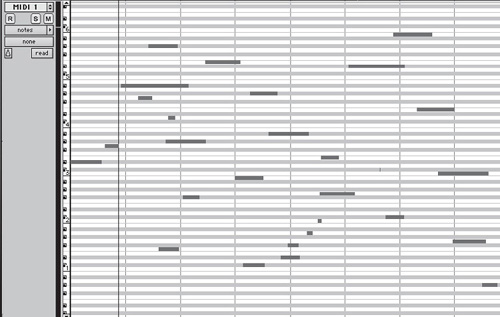
Figure P.9. The piano roll editor in a sequencer is a graphic editor in which pitch, rhythmic placement, and note length can be edited, and notes can be inserted or deleted.
pickup. A type of transducer that converts physical vibrations into electrical signals.
pickup pattern. ![]() See polar pattern.
See polar pattern.
piezo. Short for piezoelectric. A property of some materials, such as quartz and other crystals, that produces electricity when subjected to stress. Piezoelectric materials are used in a variety of transducers, such as microphones, phono cartridges, high-frequency drivers for speakers, guitar pickups, and more. Piezo crystals also work in reverse—when a voltage is applied, the crystal will vibrate at a certain rate. The rate is predictable based on the size and shape of the crystal and is extremely stable, making piezos useful for digital clocks.
piezo tweeter. A type of high-frequency driver composed of a piezoelectric crystal that moves a diaphragm to create sound waves. Piezo tweeters are inexpensive and rugged, but they may not be as accurate or linear in their response as other types of high-frequency drivers.
pigtail. 1. An audio cable with bare wires instead of connectors. 2. A breakout cable or breakout box that splits the multiple wires inside a snake cable into separate connections.
pinch roller. A rubber roller in a tape deck that presses the tape against the capstan.
ping-pong delay. A delay or echo effect in which the repeats are panned alternately left and right so that the echoes seem to bounce back and forth across the stereo field.
pink noise. A type of random noise signal used for testing purposes and containing equal energy for each octave. Pink noise sounds “bassy” and muffled to our ears. Because of how the energy is distributed in pink noise, it is useful for measuring the frequency response of audio devices as well as rooms and other spaces.
pitch. Musical quality defined by the frequency of a sound wave.
pitch bend. 1. Controlled changing in the pitch an instrument is producing. Some instruments can easily bend the pitch of notes, such as guitars, violins and other stringed instruments, trombones, and others. Other instruments produce only fixed pitches, such as pianos, harps, marimbas, and so on. 2. A wheel or other controller on a synthesizer or sampler that changes the pitch of notes played on the instrument. 3. A standardized MIDI message that changes the pitch of notes. The MIDI pitch bend message is its own type of message, not one of the continuous controllers, because smooth pitch bends require more resolution than controller messages can provide. Continuous controller messages have a resolution of 128 steps; pitch bend messages use two data bytes to increase this to 4,096 steps.
pitch correction. Using a process to “tune” the notes in a performance. This consists of modifying the pitch of a signal or file using a process that does not affect the length of the notes. There are a variety of techniques for doing this. In some cases, the pitch is automatically moved to the nearest half step or scale degree in a process analogous to rhythmic quantization. In other cases, the pitch can be corrected manually or graphically. Some pitch-correction algorithms can maintain the formants of the original sound. Others can be set to allow a certain amount of the original pitch variance (such as slight pitch bends or vibrato) to preserve the “human” aspects of the performance.
pitch envelope. An envelope generator that is routed to control the pitch or frequency parameter of an oscillator in a synthesizer or sampler.
pitch shift. A process or device that changes the pitch or frequency of an audio signal or file. Pitch shift can range from a few cents for chorusing-type effects, to an octave or even more. Some pitch shifters can change the pitch of a note without changing its length. ![]() See also pitch transpose.
See also pitch transpose.
pitch-to-MIDI. A device or process that converts a signal’s pitch or frequency to a MIDI note message. Pitch-to-MIDI devices and programs vary in their effectiveness; some are more accurate than others. There is also typically a slight lag or latency, as a full cycle of a waveform, string, or other source must be detected in order for the pitch to be converted to MIDI. This latency is more significant with low frequencies than it is with high frequencies.
pitch transpose. A process that changes the pitch of an audio signal or file, usually by a musical or scalar interval. Some modern pitch transposers are able to do this without changing the length of notes or affecting the formants or harmonic spectrum relationships of the original signal.
pitch transposer. An audio device or plug-in that manipulates or shifts the pitch of incoming signals. ![]() See also pitch transpose.
See also pitch transpose.
plate. The anode or positive component in a vacuum tube. When positive voltage is applied to the plate, electrons are attracted to it from the cathode.
plate reverb. One of the first types of mechanical reverb devices developed for recording studios. An audio signal is sent into one end of a steel plate that is suspended and tensioned by springs. The signal is picked up elsewhere on the plate by a transducer. In addition to the signal transmitted straight through the plate, some signal is reflected and bounces around. The reflections in the plate create a wash of sound, which serves as reverb. Plate reverbs were popular until the advent of digital reverbs, though virtually all digital reverbs offer a preset that emulates the sound of a plate reverb.
platter. A disk coated with magnetic oxide material within a hard drive that actually stores the data. A hard drive may contain one or more platters, depending on its capacity.
play head (a.k.a. playhead). The tape head that reads the information on a magnetic tape and converts it to an audio signal. Most DAWs feature a line or cursor that represents a virtual play head, indicating the location in the track. ![]() See also tapehead.
See also tapehead.
play list (a.k.a. playlist). A list of files or a graphic arrangement of items that determines the order in which they will play. Play lists can be used for a variety of purposes, including trying different arrangements of audio segments or regions in a track. See Figure P.10.
PLL. ![]() See phase-locked loop.
See phase-locked loop.
plosive. A human vocal sound, such as “p” or “b,” that creates a burst of air. When a burst of air from a plosive hits a microphone diaphragm, it creates a loud pop or a bassy thump. There are several techniques for avoiding plosive problems, such as angling the microphone, using a pop filter, or placing a pencil between the singer or speaker and the microphone.
plug and play. A computer feature that allows peripheral devices to work without requiring configuration or installation of a driver or other software.
plug-in. A piece of software that requires a host program to operate and that extends the capabilities of the host. Audio/music plug-ins fall into three very broad categories: audio processors and effects, virtual (software) instruments, and MIDI data processors and effects.
pocket. That place in relation to the beat where an instrumental performance sits most comfortably in the rhythmic flow of a piece or “feels” the best.
pocketing. The process of editing a track to make it fit the rhythmic feel, or pocket, of the rest of the song or performance.
podcast. A method for delivering audio and video over the Internet. A podcast consists of a digital-media file that has been made available via an RSS-syndicated feed or download.
point source monitor. A speaker in which the sound radiates from one point. In most loudspeakers, drivers producing different frequency ranges are distributed across the baffle, resulting in different frequencies coming from slightly different locations. A point source monitor uses either a single, full-range driver or a coaxial/concentric driver in which the high-frequency driver is mounted in the center of the low-frequency driver.
point-to-point wiring. A method of connecting an electronic circuit in which the components are wired directly together rather than mounted to conductive traces on a printed circuit board.
polarity invert. (a.k.a. phase reverse, phase invert, though these are technically incorrect because polarity invert has nothing to do with the phase of a signal in time.) Polarity invert is a function in mixers and DAWs that flips a signal’s polarity from positive to negative and vice versa. Polarity invert is used to verify and correct the relationship between two signals, such as two microphones on a drum kit, direct and miked tracks on a bass guitar amp, and so on. Since polarity invert only flips the polarity by 180 degrees and does not allow any other degree of phase adjustment, it will not solve all phase-cancellation problems. However, if two signals are even partially out of phase, typically flipping the polarity one way or the other on one of the signals will result in better sound.
polar pattern (a.k.a. pickup pattern). The sensitivity of a microphone to sound coming from different directions. A graph of this response is called its polar pattern. There are a number of different types of polar patterns:
cardioid. A heart-shaped polar pattern that picks up well from the front and rejects sound from the rear.
figure-8. Sound is picked up well from the front and rear, but not from the sides.
hypercardioid. Similar to cardioid, but with rejection at two points—around 150 degrees and 210 degrees from the front.
omnidirectional. Sound is picked up equally in all directions.
supercardioid. Similar to hypercardioid, with more rejection from the rear.
wide cardioid. A pattern that falls between omni and cardioid in its directionality.
pole. In analog audio, a pole is an RC (resistance and capacitance) circuit that contains one capacitor and one resistor. A one-pole circuit functions as a high-pass or low-pass filter with roughly 6 dB of attenuation per octave. Each additional pole in a filter adds another 6 dB of attenuation per octave (12 dB/octave for a two-pole filter, 18 dB/octave for a three-pole filter, and so on). Digital filters emulate this response using mathematical algorithms.
polyphonic. The ability of an instrument to play more than one note simultaneously. ![]() See also polyphony.
See also polyphony.
polyphonic aftertouch (a.k.a. polyphonic pressure). Aftertouch refers to pressure changes applied to a keyboard’s keys after the notes are struck, while the notes are sustaining. With polyphonic after-touch, each key on a keyboard can produce its own aftertouch value. Polyphonic aftertouch is carried as a MIDI channel message and has a value ranging from 0 (no aftertouch) to 127 (full after-touch). Polyphonic aftertouch can be an extremely expressive controller, though not many keyboards are capable of generating it. ![]() See also aftertouch.
See also aftertouch.
polyphony. The number of notes an instrument can sound at once. For example, a standard guitar can produce a maximum of six notes simultaneously, one per string, An upright bass, cello, viola, or violin can each produce four notes simultaneously. Most grand pianos can produce 88 notes of polyphony. Synthesizers and samplers will also have a set polyphony, ranging from a single note to hundreds of notes. Some software synthesizers are said to have unlimited polyphony, but there is a limit somewhere, set by the performance of the computer system running the synth. ![]() See also note stealing.
See also note stealing.
pop. The bassy thump or pop that results from a microphone being hit with a plosive.
pop filter. A screen made from mesh or other materials that is placed between a vocalist and a microphone to help prevent pops. The pop filter must be acoustically transparent so it doesn’t color the vocal sound, but substantial enough to break up or disperse plosive air bursts. While most pop filters are made from mesh material (nylon stockings have been used for DIY pop filters), some feature vanes or louvers that are intended to redirect air bursts.
pop-up menu. A menu that only appears when accessed with a command or with a mouse right-click and that opens in a new window. See Figure P.11.
port. An opening in a speaker cabinet intended to increase bass response. ![]() See also bass reflex.
See also bass reflex.
portable mix. A mix that sounds consistent on a variety of different playback systems. Making a mix portable, or making it translate well from the studio monitor system to consumer speaker systems, requires an accurate monitor system and a well-tuned studio with even frequency response.
portamento (a.k.a. glissando, glide). A function on some keyboards that gradually and smoothly moves the pitch of one note to the pitch of the next over a user-set period of time, producing a pitch “slide” between notes. Synth portamento was developed to emulate the ability of the human voice and certain instruments, such as violin and trombone, to smoothly slide from pitch to pitch.
ported. ![]() See bass reflex.
See bass reflex.
positional sensing. The ability of some percussion controllers to detect where on the unit’s surface a strike occurred. This positional data may be used to trigger an alternate sample or to modulate filter and other parameters to change the sound produced. This allows a more realistic emulation of an acoustic drum or other instrument, in which the sound changes pitch and tone slightly as the instrument is struck in different locations.
post-fader send. An auxiliary bus or send that derives its signal after the channel faders. The levels of signals sent to a post-fader send are affected by the position of the channel fader. Typically, post-fader sends are used as effects sends so that the level of signal sent to the effects follows the level changes created by the faders (and therefore the mix or balance of the dry signal against the effects returns stays constant).
post-production. A term that comes from the film world. In audio, post-production is processing and editing that takes place after the tracking stage of a recording is finished.
pot. ![]() See potentiometer.
See potentiometer.
potentiometer (a.k.a. pot). A variable-resistance electronic component that is used to adjust a voltage level in a circuit. Most potentiometers are rotary controls, though they can also be sliders (usually referred to as faders) or other formats.
power amp. An amplifier intended to drive a loudspeaker. ![]() See also amplifier.
See also amplifier.
power compression. Increased voice-coil resistance in a speaker that results from the coil heating up. Power compression can reduce the output of a speaker by as much as 3 to 6 dB. (Remember that losing 3 dB is equal to cutting the power of the amplifier in half.)
power conditioner (a.k.a. line conditioner). An electrical device whose function is to improve the quality of the AC power fed to other devices. Power conditioning includes protecting connected equipment against damage from surges and spikes, and EMI and RFI noise filtering to remove noise from the electrical power.
power cycle. To turn a piece of electrical equipment off and back on. Power cycling can reset memory locations and parameters that are causing instability or crashes. In most digital equipment, power cycling will reboot the software and processors and restore the default or startup state.
power regulator. ![]() See voltage regulator.
See voltage regulator.
power spike. A very short peak of high voltage in AC power. Though a power spike may not cause immediate damage, it may weaken components, leading to later failure; it may cause a click or pop; or it may corrupt digital data, among other potential problems. Most modern power supplies are designed to filter out occasional spikes. A power conditioner will also help tame spikes. ![]() See also power surge.
See also power surge.
power supply. A component or circuit in a piece of electrical equipment that converts the incoming AC wall power to the voltage and current the device requires. A power supply may also convert AC voltage to DC voltage as required by the device it is powering. The quality of the power supply is critical to the performance of most electronic equipment.
power surge. A brief increase in the voltage coming over an AC power line. Surges may have a duration anywhere from 15 milliseconds or so up to minutes long, and may be 10 to 35 percent over the normal line voltage. Most power supplies can deal with a certain amount of power surge, but very sensitive devices may have difficulty with strong surges. ![]() See also power spike.
See also power spike.
powered monitor. Though sometimes used as a synonym for active monitor, powered monitor implies a speaker that contains a power amp, without any other electronics or crossover circuitry. ![]() See also active monitor.
See also active monitor.
POW-r. 1. Psychoacoustically Optimized Word-Length Reduction. An algorithm designed to optimize sound quality when reducing word length from 20 or 24 bits to 16 bits. 2. The consortium of manufacturers that developed the POW-r algorithm. ![]() See also dither, noise shaping.
See also dither, noise shaping.
PPM. ![]() See peak program meter.
See peak program meter.
p-pop. ![]() See pop.
See pop.
PPQN. Pulses Per Quarter Note. The number of rhythmic divisions per quarter note in a MIDI sequencer, which translates to the rhythmic resolution of the sequencer. Older systems used 24 or 96 PPQN, while modern sequencers can have resolution of 960 PPQN or even higher. The higher the resolution, the finer the rhythmic “feel” the sequencer can accurately record and play back. The slower the tempo, the more critical the rhythmic resolution of the sequencer.
PQ subcode. P and Q are two of a number of types of subcode information contained on an audio compact disc and defined by the Red Book audio CD specification. (Other types include R, S, T, U, V, and W, though these are rarely used.) The P subcode is a track separator flag. The Q subcode contains data such as track number and track time. Most audio CD burning software handles PQ information in the background so the user doesn’t have to deal with it, though “pro” mastering and disc creation applications may provide access to creating and editing this subcode information directly.
P-RAM. Parameter Random Access Memory, a.k.a. PRAM. P-RAM is memory that is dedicated to storing the parameters or settings for a device. The exact use varies depending on the device. In a synthesizer, P-RAM might hold preset information. In a computer, it might hold configuration and network information. P-RAM is often battery-backed so that it retains the settings for the device even when the power is turned off.
preamp. Short for preamplifier. Electronic device used to raise the level of a very weak signal so that it can be sent to the main stage of amplification or an additional gain stage. A preamp can be a standalone device (for example, a microphone preamp), or it might be integrated into a device (for example, the preamp in a turntable or condenser microphone). Some preamps are intended to be extremely clean and accurate; others are intended to impart a particular “flavor” or signature characteristic to a signal.
precedence effect. ![]() See Haas effect.
See Haas effect.
pre-delay. A parameter in reverb units that sets the length of time between the initial source signal and the appearance of reverb. Setting the pre-delay time properly is essential for maintaining the clarity of a mix. See Figure P.12.

Figure P.12. Pre-delay is the amount of time that elapses after a sound (a snare drum, in this case) and before the onset of reverb.
pre-fade listen. ![]() See PFL.
See PFL.
pre-fader send. An auxiliary bus or send that derives its signal before the channel faders. The levels of signals sent to pre-fader send are not affected by the position of the channel fader. Typically, pre-fader sends are used as monitor sends so that the engineer can create a mix using the faders without affecting what is heard through the monitor or headphone system.
preference file. A file created by a device’s user that defines certain aspects of how the device will operate, specifies default settings for global parameters, and customizes the work environment to how the user prefers to work.
preferences. ![]() See preference file.
See preference file.
pre-polarized. A type of condenser microphone capsule that holds a fixed charge and does not require external power. ![]() See also electret.
See also electret.
pre-production. Work on a piece of music that takes place before any recording sessions take place in the studio. This might include rehearsing, working on arrangements, defining and refining parts, and more. Often the producer of the project will participate and assist with preparing the music for recording.
presence. A frequency range that determines how well a sound will cut through a mix, or how “forward” it will appear for a given volume level. Presence is generally defined to be in the 3- to 4-kHz range. Guitar amplifiers often have a presence control, though any sound can be made more or less present by adjusting this range.
presence peak. A bump or small rise in the upper-mid- and high-frequency response of a microphone. A presence peak will make a signal from the microphone seem louder without increasing the volume, and can add clarity and definition to a signal. Many microphones aimed at vocal use have a presence peak to bring the voice forward and to increase intelligibility.
preset (a.k.a. program, patch). The parameter settings, algorithms, samples, and other data required to create a specific synthesizer sound, processor effect, or mode of operation for a device, saved as a group to a memory location. Presets can be stored and recalled so the user can instantly and exactly recreate the specific setting. Examples of presets would include a piano sound in a synth or sampler, a particular echo setting in an effects processor, a specific zoom setting for a DAW editing window, and so on. Most digital devices and many software programs contain various types of preset saving/recalling abilities. There are two broad categories of presets: RAM and ROM. RAM (a.k.a. user) presets are editable and can be overwritten with new data. ROM (a.k.a. factory) presets can be edited, but cannot be overwritten—the preset location is locked, and new data cannot be written there. (However, a ROM preset could be loaded into the device and modified, and then saved to a RAM location if desired.)
pressure. ![]() See aftertouch.
See aftertouch.
pressure microphone (a.k.a. pressure operative microphone). A type of microphone in which only one side of the diaphragm is exposed to incoming sound waves. Because there is no cancellation to create a directional response, pressure microphones have an omnidirectional polar pattern.
pressure-gradient microphone (a.k.a. velocity microphone). A type of microphone in which both sides of the diaphragm are exposed to incoming sound waves. The microphone responds to pressure differences between the two sides. Since sound waves that arrive parallel to the diaphragm create no pressure difference between the two sides, there is a null in the response from the sides, resulting in the figure-8 polar pattern.
pressure-zone microphone. ![]() See PZM.
See PZM.
preview. 1. A feature of some offline or non-realtime processors that allows the user to hear a sample of what a process will sound like after it has been applied to a track or a file. Preview was especially important when most offline processors were destructive (actually changed the data in a file) and there was no undo ability. 2. An application that comes with Apple Macintosh computers and that can open graphic and PDF files.
print. 1. Slang term for recording a signal to analog tape. 2. Converting sequencer-driven synthesizer or sampler parts to audio tracks by recording them. 3. Recording the output of effects devices, such as reverbs and delays, to audio tracks to preserve them as part of a session or so the effects devices can be reused for other tasks. 4. To output text or graphics from a computer onto paper.
print-through (a.k.a. interlayer transfer). A phenomenon that occurs with analog tape reels where the magnetism stored on one layer of the reel magnetizes the adjacent layer of tape. Print-through becomes a problem when loud passages on one layer of tape magnetize a silent area between songs or parts of songs on the next layer and become audible as a “pre-echo.” To counter pre-echo, most engineers store analog tape “tails out,” so that the end of the tape is on the outside of the reel. This generally results in the print-through being masked by other parts of the song rather than falling in silent areas between songs.
pro. ![]() See professional.
See professional.
processor. 1. The chip on a computer’s motherboard that is the primary engine managing and performing operations and actions. ![]() See also CPU. 2. A device that modifies or enhances audio signals. Examples include compressors, delays, flangers, equalizers, reverbs, and limiters. 3. A device that modifies or enhances MIDI data.
See also CPU. 2. A device that modifies or enhances audio signals. Examples include compressors, delays, flangers, equalizers, reverbs, and limiters. 3. A device that modifies or enhances MIDI data.
producer. A person responsible for managing the production of a piece of music or an album. A producer is involved with coaching, organizing, and scheduling the production; is in charge of managing the financial and budget aspects of a project; oversees sessions; and supervises the mixing and mastering processes. Some producers become true creative partners with the artists they work with, helping with arrangements, musical decisions, and more.
professional. 1. A musician, producer, or engineer who earns the majority of his living working in the audio or music field. 2. Possessing the skills, ability, and equipment to function in the audio or music professions. 3. Equipment worthy of or intended for use by professionals. ![]() See also consumer, semi-pro.
See also consumer, semi-pro.
program. 1. A patch or preset in a device. ![]() See also preset. 2. To create new sounds, patterns, sequences, loops, or other performance data in a digital music device.
See also preset. 2. To create new sounds, patterns, sequences, loops, or other performance data in a digital music device.
program change. A MIDI channel message that tells the receiving device to recall/load a specific preset or program. There are 128 available program change numbers, ranging from 0 through 127. ![]() See also patch mapping, bank select.
See also patch mapping, bank select.
program-dependent compressor. A compressor whose response varies according to the frequency and amplitude content of audio signals. Typically, the attack and release times are made program-dependent, which helps with maintaining and controlling transients and reducing pumping and breathing artifacts. Examples include the Universal Audio LA-2A, the dbx 160SL and 1066, and the Fairchild 670.
progressive hammer action. ![]() See graded hammer action.
See graded hammer action.
project studio. A personal recording studio. A project studio may or may not be a home studio, but is typically owned and used by one artist, or is owned and used by an engineer or producer for his projects.
propagation. The motion of waves through or in a medium, progressing from molecule to molecule. The molecules don’t move with the wave; the vibration of one molecule is passed along to the next molecule, and so on. A great example is a person starting the wave in a stadium. The next person picks up the wave, and so on, until the wave has moved all the way through the crowd and around the stadium.
property. A preference, parameter, or characteristic that defines and describes how a piece of gear or software operates.
proprietary. A process or piece of hardware or software developed by a manufacturer and limited to use in that manufacturer’s prod-uct(s). Examples might include hardware that only works with its manufacturer’s software, a plug-in that only works in its manufacturer’s DAW, a synthesizer that only works with specially formatted floppy disks, and so on. While proprietary is often considered to be a bad thing, it can also result in better compatibility, improved functions, and other benefits.
protocol. A standard for transmitting and receiving data between devices or over a network. A protocol may include specifications for transmission, reception, data compression, housekeeping messages, and more. USB, MIDI, SCSI, FireWire, ATA, and others are examples of protocols.
Pro Tools. A family of computer-based DAW hardware and software systems manufactured by Digidesign.
proximity effect (a.k.a. bass tip-up). A distortion in frequency response, usually low-frequency boost, resulting from a directional microphone being placed close to a source. (Omnidirectional microphones do not exhibit proximity effect.) Proximity effect may result in a boost in level up to 16 dB below 100 Hz when a microphone is right up on a source; the bass response will decrease as the mic’s distance from the source increases. Radio announcers and some vocalists love proximity effect, as it makes their voices sound fuller. Engineers use careful placement and proximity effect to control the low end when tracking or miking a live performance.
psychoacoustics. 1. A branch of psychology that studies how humans perceive sound and extract information from acoustics. 2. Properties used to trick the brain of a listener into misinterpreting sonic cues. Examples include diffusors that make a room seem larger than it actually is, one sound masking another sound, psychoacoustic models used in lossy compression algorithms, and more.
pulldown. 1. ![]() See pull-down menu. 2. An audio/video production technique for matching film frame rates to video rates.
See pull-down menu. 2. An audio/video production technique for matching film frame rates to video rates.
pull-down menu (a.k.a. drop-down menu). A menu that appears when selecting a word or item in a program with a mouse click (see Figure P.13). ![]() See also menu, pop-up menu, contextual menu.
See also menu, pop-up menu, contextual menu.
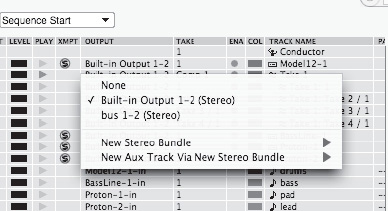
Figure P.13. Pull-down menus are accessed with a mouse click on an item in a program or operating system.
pulse. A sharp rise and fall in voltage somewhat similar to a square wave, though a pulse is usually shorter than a square wave. A stream of pulses can be used as an analog clock.
pulse code modulation. ![]() See PCM.
See PCM.
pulse wave (a.k.a. rectangular wave). A waveform related to a square wave, but that is not symmetrical. The shape of the wave is determined by its duty cycle (see Figure P.14). Pulse waves have extensive harmonic content and are sometimes described as “hard” and “buzzy” sounding. ![]() See also pulse width modulation.
See also pulse width modulation.
pulse width modulation (a.k.a. PWM). A square wave whose pulse width or duty cycle is modulated by a low-frequency signal or a controller, such as velocity or a continuous controller. Pulse width modulation is used in synthesizers to create waveforms whose harmonic content is continuously varying.
pumping. An artifact occurring in a compressor when its release time is set too long. When the release is too long, audio below the threshold that follows audio that has been compressed will also be compressed, pushing it down in the mix. That audio then slowly rises up to its normal level. ![]() See also breathing.
See also breathing.
punch. ![]() See punch-in.
See punch-in.
punch block. A type of electrical connection strip where wire is pressed into a V-shaped metal terminal using a punch-down tool. The terminal cuts through the wire’s insulation and makes electrical contact. No soldering or insulation stripping is required with punch blocks.
punch in. The technique of replacing small portions within an existing track by quickly putting the recorder into record mode at a specific point and recording new audio. Older tape machines required manually dropping the recorder into and out of record mode. Newer machines can automatically drop into and out of record at user-programmed points. Sequencers and DAWs also support punching in and out of MIDI and audio tracks. A punch in may be as short as a single word or note in a track or as long as replacing the majority of a track.
punch out. Switching a recorder out of record mode after punching in.
Purple Book. One of a set of “Rainbow Books” with colored covers containing the Sony/Philips-developed specifications for different optical compact disc formats. The Purple Book contains the specification for double-density CD (DDCD), which can store up to 1.3 GB on a single disc.
push-pull. An amplifier circuit in which two components are used to drive the current—one for the positive state or part of the waveform and one for the negative state or part of the waveform. One switches off while the other is on, and vice versa. ![]() See also single-ended.
See also single-ended.
PWM. ![]() See pulse width modulation.
See pulse width modulation.
PZM. Pressure-zone microphone. A term trademarked by Crown. ![]() See also boundary microphone.
See also boundary microphone.

